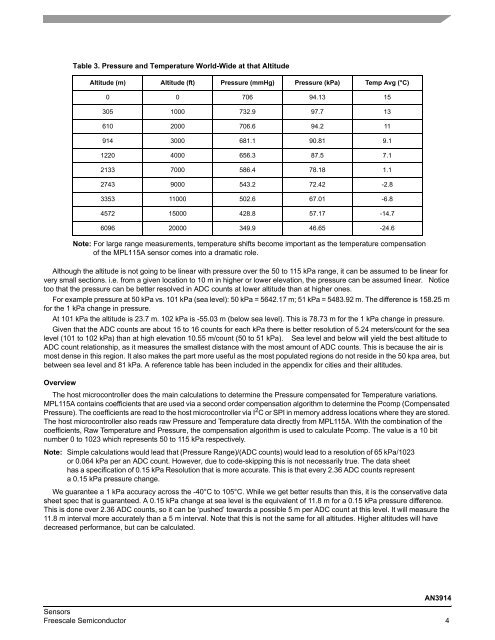AN3914, Modern Altimeter and Barometer System using ... - Freescale
AN3914, Modern Altimeter and Barometer System using ... - Freescale
AN3914, Modern Altimeter and Barometer System using ... - Freescale
Create successful ePaper yourself
Turn your PDF publications into a flip-book with our unique Google optimized e-Paper software.
Table 3. Pressure <strong>and</strong> Temperature World-Wide at that Altitude<br />
Altitude (m) Altitude (ft) Pressure (mmHg) Pressure (kPa) Temp Avg (°C)<br />
0 0 706 94.13 15<br />
305 1000 732.9 97.7 13<br />
610 2000 706.6 94.2 11<br />
914 3000 681.1 90.81 9.1<br />
1220 4000 656.3 87.5 7.1<br />
2133 7000 586.4 78.18 1.1<br />
2743 9000 543.2 72.42 -2.8<br />
3353 11000 502.6 67.01 -6.8<br />
4572 15000 428.8 57.17 -14.7<br />
6096 20000 349.9 46.65 -24.6<br />
Note: For large range measurements, temperature shifts become important as the temperature compensation<br />
of the MPL115A sensor comes into a dramatic role.<br />
Although the altitude is not going to be linear with pressure over the 50 to 115 kPa range, it can be assumed to be linear for<br />
very small sections. i.e. from a given location to 10 m in higher or lower elevation, the pressure can be assumed linear. Notice<br />
too that the pressure can be better resolved in ADC counts at lower altitude than at higher ones.<br />
For example pressure at 50 kPa vs. 101 kPa (sea level): 50 kPa = 5642.17 m; 51 kPa = 5483.92 m. The difference is 158.25 m<br />
for the 1 kPa change in pressure.<br />
At 101 kPa the altitude is 23.7 m. 102 kPa is -55.03 m (below sea level). This is 78.73 m for the 1 kPa change in pressure.<br />
Given that the ADC counts are about 15 to 16 counts for each kPa there is better resolution of 5.24 meters/count for the sea<br />
level (101 to 102 kPa) than at high elevation 10.55 m/count (50 to 51 kPa). Sea level <strong>and</strong> below will yield the best altitude to<br />
ADC count relationship, as it measures the smallest distance with the most amount of ADC counts. This is because the air is<br />
most dense in this region. It also makes the part more useful as the most populated regions do not reside in the 50 kpa area, but<br />
between sea level <strong>and</strong> 81 kPa. A reference table has been included in the appendix for cities <strong>and</strong> their altitudes.<br />
Overview<br />
The host microcontroller does the main calculations to determine the Pressure compensated for Temperature variations.<br />
MPL115A contains coefficients that are used via a second order compensation algorithm to determine the Pcomp (Compensated<br />
Pressure). The coefficients are read to the host microcontroller via I 2 C or SPI in memory address locations where they are stored.<br />
The host microcontroller also reads raw Pressure <strong>and</strong> Temperature data directly from MPL115A. With the combination of the<br />
coefficients, Raw Temperature <strong>and</strong> Pressure, the compensation algorithm is used to calculate Pcomp. The value is a 10 bit<br />
number 0 to 1023 which represents 50 to 115 kPa respectively.<br />
Note: Simple calculations would lead that (Pressure Range)/(ADC counts) would lead to a resolution of 65 kPa/1023<br />
or 0.064 kPa per an ADC count. However, due to code-skipping this is not necessarily true. The data sheet<br />
has a specification of 0.15 kPa Resolution that is more accurate. This is that every 2.36 ADC counts represent<br />
a 0.15 kPa pressure change.<br />
We guarantee a 1 kPa accuracy across the -40°C to 105°C. While we get better results than this, it is the conservative data<br />
sheet spec that is guaranteed. A 0.15 kPa change at sea level is the equivalent of 11.8 m for a 0.15 kPa pressure difference.<br />
This is done over 2.36 ADC counts, so it can be ‘pushed’ towards a possible 5 m per ADC count at this level. It will measure the<br />
11.8 m interval more accurately than a 5 m interval. Note that this is not the same for all altitudes. Higher altitudes will have<br />
decreased performance, but can be calculated.<br />
<strong>AN3914</strong><br />
Sensors<br />
<strong>Freescale</strong> Semiconductor 4













